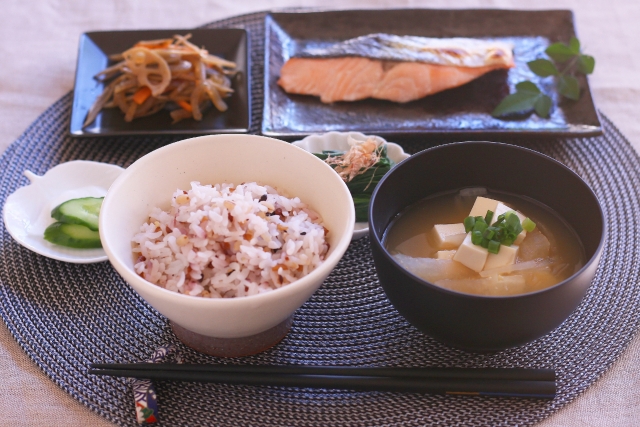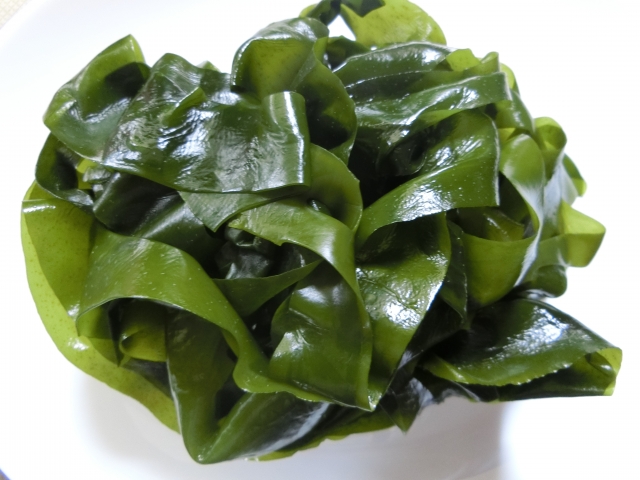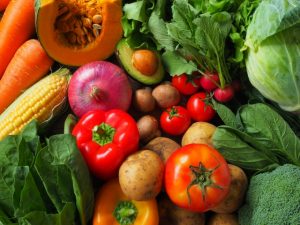Six Reasons Why Washoku is Healthy
Washoku has been registered as a UNESCO Intangible Cultural Heritage of Humanity, for the following characteristics.
1.Diversity and freshness of ingredients, and respect for their inherent flavors.
2.An exceptionally well-balanced and healthy diet.
3.An expression of natural beauty and the changing seasons.
4.Close links with annual events.
One of them is being a well-balanced and healthy diet. In that case, what aspects of Washoku are well-balanced and healthy?
1. Ichiju-Sansai Brings Good balance of carbohydrate, protein, and vitamin
Most meals in Japan have a good balance of carbohydrate-based food, protein-based food, and vitamin-based food, while it isn’t the case in some countries. For example, in English speaking countries, you might have eggs and sausages with bread without vegetables for breakfast.

In Japan, we have rice, miso soup, pickles, and natto or eggs. Miso soup usually contains some vegetables, so along with pickles, we get a good portion of vegetables for breakfast.
For school lunch, you might have just fried chicken and French fries, without vegetables. Or you might have peanut butter on bread, crisps, and an apple or banana. In this case, you have fruit, and therefore you have vitamin-based food, but in my opinion, fruits and vegetables are different in terms of sugar intake. In Japan, school lunches usually consist of rice or bread, soup, a vegetable dish, and a protein-based dish.

It comes from a tradition of Ichiju Sansai, which means one soup three dishes. From Washoku’s point of view, each meal should contain a staple, which is usually rice, soup, pickles, and three side dishes. One of the side dishes is protein-based, such as fish or a soybean-based food like natto or tofu. Recently, more people are adding meat into their diet. The other two are vegetable-based.
We usually have vegetables in all meals, and we probably eat a lot more vegetables each day than the average people in English speaking countries do.
2. We don’t eat so much sweet
We don’t have anything sweet for breakfast, such as cereal with sugar, muffins, or pancakes. We don’t have the custom of having dessert after dinner.
Even for our tea breaks, we have green tea with pickles, not with cakes or donuts.
3. We have a lot of fermented foods

We have a lot of fermented foods such as miso, soy sauce, natto, and pickles. Fermented foods are considered to be good for our gut microbiota.
4. We eat a lot of seaweed

We eat a lot of seaweed such as Wakame, Konbu, Hijiki, and Nori.
5. We have a variety of ways to prepare vegetables
We have a variety of ways to prepare vegetables, such as Nimono, stewing, Sunomono, vinegaring, Aemono, seasoning, and Tsukemono, pickling. In the process, we use sesame seeds or vinegar, which are said to have some health benefits.

Nimono, stewed vegetables.

Sunomono, vinegared vegetables

Aemono, seasoned vegetables
6. We eat much less
Generally speaking, we eat much less. That is seen in the amount of each serving at fast food restaurants; you’ll be surprised to see how small each portion is when you come to Japan. Our large size coffee is your small size coffee.
We have a tradition called Hara Hachibunme, which means to stop eating when you are 80% full. Therefore, we don’t eat so much.
Because of these six characteristics, I think Washoku is in pretty good shape in spite of the fact that it contains white rice. Most of us eat two to four bowls of rice, anyway. It isn’t like the way people in short-lived villages ate, four to seven bowls of rice. We have more side dishes in modern-day Washoku so that we don’t need to eat so much rice.
With that said, I don’t recommend Washoku as we know it as a healthy diet, since it isn’t what the healthiest people in Japan eat.
So, what kind of diet do I recommend and who are the healthiest people in Japan?
To get into that, we need to look into Ogimi village in Okinawa again.
The Ikigai Diet: The Secret Japanese Diet to Health and Longevity
POD Paperback
https://www.amazon.com/gp/product/4991064864
Kindle

